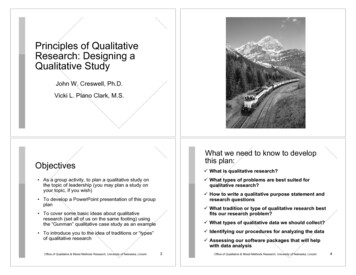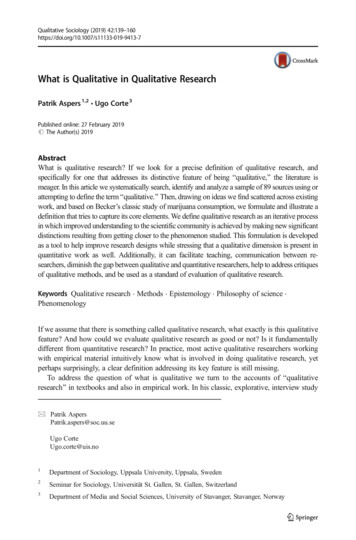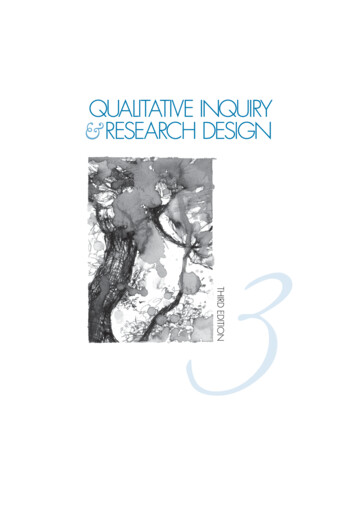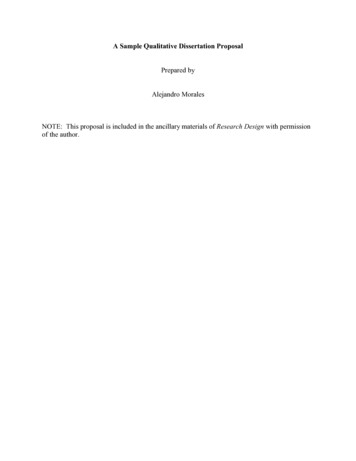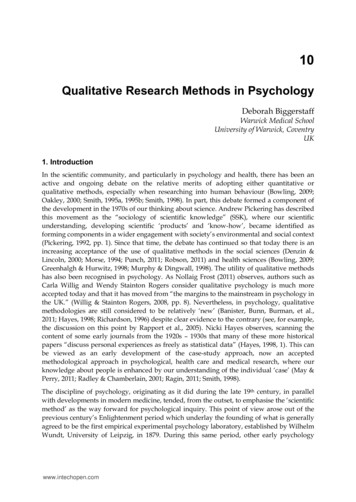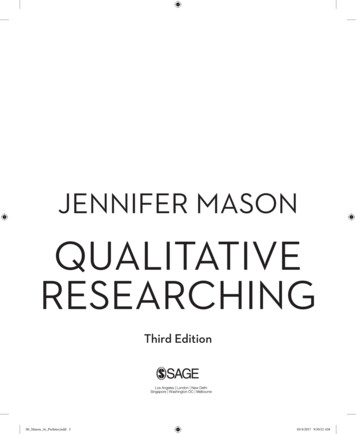
Transcription
JENNIFER MASONQUALITATIVERESEARCHINGThird Edition00 Mason 3e Prelims.indd 310/4/2017 9:50:52 AM
ContentsAcknowledgementsPreface and introduction to the third edition of this bookPART IRESEARCH STRATEGY AND DESIGN1 Intellectual puzzles and research questionsviiix132 Choosing methods and planning your approach213 Sampling and selecting in qualitative research534 Ethics83PART IIGENERATING DATA1075 Qualitative interviewing1096 Observing and participating1397 Being creative with methods163PART III ANALYSING DATA1858 Making sense of qualitative data1879 Making convincing arguments with qualitative data219ReferencesIndex25526700 Mason 3e Prelims.indd 510/4/2017 9:50:52 AM
8Making Sense ofQualitative DataMaking sense of qualitative data, in their various shapes and forms, may be both dauntingand labour intensive, but it is also exciting and engaging. This is where you start having ideasabout your data, interpreting them and working out what you think they say, or what you cansay on the basis of them. But you also need to find effective ways of organizing and managingmaterials that are likely to be unstructured, multifarious and eclectic, so that you can assemblethem, have them at your fingertips, and move easily among and through them in ways that willenable you to draw insights and make interpretations. This can feel challenging and, at times,even overwhelming, so it important to approach it in a calm and steady manner. We will covertwo broad and overlapping spheres of activity in this chapter: organizing your data, and interpreting your data. It is important, in both these spheres, not simply to follow in an unthinkingway what seem to be the conventions and rules for how these things are usually done in yourdiscipline or field. Instead, we will see that you should engage in active epistemological thinking that is both creative and systematic, through all the processes involved. In doing so, thewhole experience will come to seem less overwhelming and much more engaging.ORGANIZING YOUR DATAOrganizing data is a practical challenge, but it is also always an epistemological one. Evenapparently mundane or insignificant decisions will have implications for how you are ableto interpret your data, as well as what kind of argument you will be able to make on thebasis of your research. First and foremost, organizing data involves recognizing what actuallyconstitutes data in your study, and understanding what you want from these data. Then you08 Mason 3e Ch-08 Part III.indd 18710/4/2017 9:51:06 AM
Qualitative Researchingcan start finding ways to store, organize, assemble, index, search and retrieve your data, thatare conducive with and facilitate the making of interpretations, and are consistent with yourepistemological approach and the form of your intellectual puzzle (as discussed in Chapter 1).Recognizing data and understanding what you wantfrom themQualitative data can take a range of forms. Table 8.1 lists some of the most common;however, you may generate materials that are not mentioned but that you would still want tothink of as data.As you can see, and as has been implied by the discussions in Chapters 5, 6 and 7,qualitative data can come in many shapes, sizes and textures, and indeed any ‘piece’ of datacan take multiple forms (an online chat can become an audio or video recording, a screenshotTable 8.1 Forms of qualitative dataInterview transcripts, and partial transcriptsDiagramsInterview notesOther artistic or craft creations (e.g. collage,models, sewing, knitting, food/meals)Transcripts of ‘naturally occurring’ talk, onlinechats etc.Material things, objects, textures (e.g.ornaments, artefacts, textiles, clothing)FieldnotesOther notes, jottings (yours or those of others),researcher’s analytical notes (handwritten ordigital)Audio recordings (of any sounds, e.g. speech,events and happenings, music)MapsPhotographs (physical, digital – canbe of anything, e.g. people, animals,environments, material structures, objectsand things, weather, documents)Other documents (physical, digital)Video recordings (which will probably also beaudio recordings)Other sensory data (e.g. smell, touch, taste,temperature, weather, movement, rhythm – maybe recorded in words, video, audio, or othermodes)Written accounts, diaries, experience stories,narratives (physical – typed, handwritten, digital,text, photo, video)Drawings, sketches, paintingsOn-screen/online materials and ‘live’ data(e.g. web pages, chats, web postings,maps, emails, texts, chats, hyperlinks,browsing histories, transcripts, screenshots,transactional data and online metrics, GPStracking and locational data)Researcher’s own ‘live’ experiences,memories, feelings, impressions, intuitions,interpretations; things they have noticed,witnessed, seen, heard, been told, felt(whether or not these are turned intofieldnotes, analytical notes, or other formsmore readily recognized as data).18808 Mason 3e Ch-08 Part III.indd 18810/4/2017 9:51:06 AM
Making Sense of Qualitative Dataor set of stills, a transcript, a set of analytical or fieldnotes, a portal to other links, or even aset of metrics about the participants and the dynamics of the chat). Qualitative data can besolid and permanent, or ephemeral and intangible. Researchers will usually try to turn thelatter into something more solid as part of the analytical process (for example in producinga transcript or a partial transcript of a conversation, or a video of a political rally, or a sketchof someone’s living room, or sets of analytical notes to capture their own ‘live’ impressions).But if we accept the Oxford Dictionary of English philosophical definition of data as ‘thingsknown or assumed as fact, making the basis of reasoning or calculation’ (Oxford Dictionaryof English, 2005: 441), then I think we should recognize that these more intangible forms ofknowledge do constitute qualitative data in the sense that they may be some of the ‘thingsknown’ on which our interpretations are based. What count as data in my study?How are they data – literally, interpretively, reflexively, otherwise?What do I want and need from my data?What is their relationship to the phenomena I wish to study?The important question of what counts as data in your study is one that you should explicitlyask yourself during and after the data-generation process, and we have looked at these issuesin some detail in relation to interviews, observation and being creative with methods in theprevious three chapters. As I suggested there, the answer to the question of what counts asdata is not always obvious or a foregone conclusion, and you should not proceed as thoughit were. Essentially, when it comes to thinking about how to organize your data, what youare asking yourself is ‘What do I need to take account of, from amongst the materials I havegenerated, in order to explain what is going on in relation to my intellectual puzzle?’, or‘What, from amongst the materials, might provide insights?’. It is important that you lookat these issues afresh in these later stages of your research. As I suggested in Chapter 1 (seeBox 1.2), your puzzle might have been developmental, mechanical, processual, ecological,experiential, comparative, causal/predictive or a thick description, and you will now needto consider what materials you need to piece together, and in what ways, in order to build areasonable explanation in those terms.At these later stages you will be able to take stock of what kinds of data you have actuallygenerated and assess their status and value in producing meaningful knowledge, so you willhave the benefit of not having to work aspirationally or in the abstract. Asking what countsas data will require you to track back to the ontological and epistemological perspectivesthat underpin your research, and how these have played out in your intellectual puzzle, yourresearch questions, your choice of methods and in how you have gone about generating data.18908 Mason 3e Ch-08 Part III.indd 18910/4/2017 9:51:06 AM
Qualitative ResearchingIf you refer back to the discussion of knowledge and evidence in Chapter 1, and to the different approaches summarized in Box 1.1 for example, you will be reminded that differentsocial scientific epistemological perspectives have different ideas about what might constitute knowledge or evidence of the ontological properties that they are interested in, and yourown answers to these questions will have informed your intellectual puzzle, your researchquestions and your methods.In the later stages of the process, asking yourself what counts as data enables you to viewthese connections again but in the other direction and with the benefit of experience of theresearch process, so you can look at what you have generated and consider what you can use,what you need to use and what you want to use in answering the questions you started outwith. Reflecting back in this way is therefore important for a number of reasons. It enablesyou to examine how, and how well, different materials that you have generated (such as thosetypes listed in Table 8.1) will help you to do that, and thus which ones might start to formthe building blocks for your analysis and interpretation. It will also help you to think throughwhat role different types of materials you have generated might play in the overall intellectual puzzle where you might have used a mix of methods and approaches for example, so thatyou can work out how the different forms of data support different parts of your investigation, and how the mix comes together (see Chapter 2). It also helps you to recognize if yourfocus has shifted during the data-generation process. For example, the types of materials youhave actually generated may lead you to reconfigure your original research questions, or torevise your intellectual puzzle so that it takes a different form (see Box 1.2) or to see yourepistemological perspective and any broad social science approaches that you have wantedto be aligned with somewhat differently (see Box 1.1), or even to reflect on different ontological properties (see Table 1.1) than those with which you began. Importantly, you mayalso find at this stage that you want to use materials you have generated or encounters youhave had that you had not beforehand anticipated would constitute data in their own right,but which you now feel are important components of the knowledge that you want to usein developing your interpretations and arguments. But perhaps most significantly, reflectingback like this means that you will be engaging in active epistemological thinking of the kindthat is vital not only for good qualitative research, but so that you will be able to work outhow best to organize, manage and handle your data to facilitate interpretation and insight.I introduced the ideas of literal, interpretive and reflexive readings of data in Chapters 5, 6and 7 and you may find it helpful to consider these when you are working out what you wantand need from your data, and thus how might organize them.Literal readings. If you are intending to ‘read’ your data literally, you will be interestedin their literal form, content, structure, style, layout, and so on. So, for example, if you areworking with interview transcripts, you might be interested in the words and language used,the sequence of interaction, the form and structure of the dialogue, and the literal content.Similarly, if you are working with documents, video, film, visual artefacts, or whatever, a19008 Mason 3e Ch-08 Part III.indd 19010/4/2017 9:51:06 AM
Making Sense of Qualitative Dataliteral reading will mean that you are interested in documenting a literal version of their content or ‘what is there’. While you may want to make such literal readings, most qualitativeresearchers will not want to stop there. Indeed, many would suggest that a purely literal reading is not possible, just as a purely objective description is not possible, because the socialworld is always already interpreted and because what we see is shaped by how we see it.Interpretive readings. Whatever your view on the possibility or otherwise of literal readings, you will need to consider to what extent you will want to make an interpretive readingof your data. An interpretive reading will involve you in constructing or documenting aversion of what you think the data mean or represent or signify, or what you think you caninfer from them, or what other phenomena they tell you about. In some cases, researchersare less interested in the literal form of the data, and more interested in what phenomenaor concepts they can potentially lead to. You may, for example, read a section of an interview transcript as telling you something about implicit norms or rules with which theinterviewee is operating, or discourses by which they are influenced, or something abouthow discourses are constituted, or as indicating some kind of causal mechanism in socialaction. You may be interested in absences and what is not said, because you think this tellsyou about important phenomena. You may be mostly concerned with what you see as yourinterviewees’ interpretations and understandings, or their versions and accounts of howthey make sense of social phenomena, or you may place more emphasis on your own interpretations. Probably, you will do both to an extent. Whatever form of interpretive readingyou adopt, you will be involved in reading through or beyond the data in some way, bethey texts, artefacts, visual images or whatever.Reflexive readings. A reflexive reading will locate you and your interaction with participants as part of the data you have generated, and will seek to explore your role andperspective in the process of generation and interpretation of data. You will probably seeyourself as inevitably and inextricably implicated in the data generation and interpretation processes, and you will therefore seek a reading of data which captures or expressesthose relationships.Many qualitative researchers make readings of their data on all three of these levels, andwe have already discussed (in Chapters 5, 6 and 7) the implications of the different forms ofreading for what you actually generate and record as data. For example, if you wish to readdocumentary data or visual images on all three levels you will need to have generated notonly literal documents, but also data concerning perhaps the context of their production, consumption, interpretation and use, and data concerning your role in that – and you will want tosee all of those as data, and find ways to organize them. The different types of reading havedifferent implications for what you treat as data so that, for example, fieldnotes documentingyour own response to a situation, or providing an account of how you interpreted what washappening at the time, how you interpreted it later, and so on, are more likely to be viewed asdata in relation to reflexive than literal readings. What this means is that, whatever it is that19108 Mason 3e Ch-08 Part III.indd 19110/4/2017 9:51:06 AM
Qualitative Researchingwill be counted as data according to your perspective and the reading you wish to make, thismust take a form (or be put into a form) that can be readily sorted and organized for analytical purposes in accordance with the epistemological approach and form of intellectual puzzleyou are deploying (see Boxes 1.1 and 1.2 in Chapter 1). So, if you have analytical notes andmemos, you will need to decide to what extent they can and should constitute data that willbe sorted and organized. If you are using your ‘live’ experiences – your memories, impressions, and so on – as data, you need to think critically and honestly about how to organizeand use them, and whether you need to transform them into something more ‘solid’, such asanalytical or fieldnotes.Data management What form do I need the data to be in? What are the relevant organizational units?How will I be able to familiarize myself with the data, and get to know them really well?How will I be able to retrieve, search, assemble, collate and cross reference them – orwhatever else I might want to do with them?What do I need to keep? How and where? How do I keep my data safe and secure?You will need to engage with the practical – and yet it is also of course epistemological –question of what form your data need to be in, as well as what you need to keep, and where.Do you need, for example, to transcribe interview recordings (or use voice recognition software to produce transcripts), or to partially transcribe them, or do you want to use the audiofiles? Do you need hard copies of photographs for example, or of transcripts, or do youwant to take stills from film and video, or screenshots from the internet or PDFs from digital archives, and print these out? Or conversely, if your data are artefacts and things, orlandscapes and settings, do you need to take photographs of them, or write descriptions andcommentaries about them, or make sketches of them? And will these then take hard copyand/or digital form? Electronic and digitized data are now so easy to produce and to manage,manipulate, access, store and move that in some ways they have transformed the forms thatqualitative data can take and the ease of working with them, yet many qualitative researchersstill like the touch and feel of physical and hard copy materials. You will also need to considerpractical questions like the resource requirements for different forms of data storage –for example, you will likely need large amounts of secure, accessible physical space if yourdata take the form of hard copies, or physical artefacts, and you may need to protect themfrom dust, moisture and light. You may need a secure and encrypted server, online storageor hard drive, and good quality equipment to keep materials digitally, and to ensure they do19208 Mason 3e Ch-08 Part III.indd 19210/4/2017 9:51:06 AM
Making Sense of Qualitative Datanot lose their sensory vibrancy or immediacy because of technical shortcomings. You willneed to consider how long you can and should keep your materials for – whatever form theytake – and whether you will have continued rights and access as their custodian. There maybe data-management protocols and institutional requirements or restrictions that you need toadhere to (see also Chapter 4 on ethical issues), and you may need to think about whether youwill deposit some of your materials in archives and, if so, what shape or form they will needto take and what data preparation might be required – anonymization for example, or specialkinds of formatting. And of course you will want to consider how you can keep duplicatesand back-ups. Often, these kinds of considerations make demands on your and other people’slabour that you will need to factor into your plans.As mentioned, these kinds of questions are not simply practical ones. In working out whatform your data should take, and what kinds of preparation might be needed, you will needto be closely attending to those questions about what you want and need from your data.For most qualitative researchers, a first step with their data, especially when they are feeling overwhelmed by their sheer scale and apparent amorphousness, is to get really familiarwith what is there. So in working out what form your data should take and how you mightorganize them, you should consider how you can develop this close familiarity. Sometimesthe practical tasks involved in basic data organization can help here. For example, if you aretranscribing your own interviews, or organizing your photographs into electronic or physicalfolders, and basically reading, listening to, looking at and assembling your data, you start tobecome very familiar with them.But of course you will also want to devise mechanisms and practices that can help youmove easily in and through your data; to search, retrieve and cross reference within your dataand possibly to ‘external’ sources; and to be able to assemble and collate your data, or streamthem simultaneously – all in ways that will aid you in having ideas, making interpretations,building explanations and arguments. In a sense this is like the points made in Chapters 5,6 and 7 about using methods to get you into the right kind of zone from which knowledgecan be generated. So too with organizing and managing your data – you need strategies andpractices that will easily enable you, the active researcher and epistemological thinker, to getinto the right kind of analytically generative zone with your data. Your data-management andorganizational systems need to be inspired as well as pragmatic therefore!So, in organizing your data, I recommend that you think carefully about questions likewhat you will want to be able to find, search for, retrieve, manipulate, and to have at yourfingertips. What kinds of tags or metadata might you want to create and apply? What arethe units of analysis you will want to use? These should relate to your epistemologicalapproach and the form of your intellectual puzzle (as in Boxes 1.1 and 1.2, Chapter 1). So,for example, if your units are interactions, or if they are people, or if they are biographies, orif they are interpretive themes, or sequences of talk, or underlying mechanisms, or sets ofobject relations – then you will need a system that will allow you to identify and find these.19308 Mason 3e Ch-08 Part III.indd 19310/4/2017 9:51:06 AM
Qualitative ResearchingSimilarly, if you are posing a developmental puzzle, or a mechanical puzzle, or a processualpuzzle, for example, you will need to be able to assemble your materials in ways that helpyou to have ideas and draw inferences about how something has developed, the chronologyof it, how something works, or how things change, and so on. Importantly, you will alsowant to be able to test out your developing explanation (see Chapter 9), so you will need tothink about how your materials might need to be organized so that you can explore ‘counterfactuals’ or alternative possible explanations.These points may seem obvious and uncontroversial, but many qualitative researchers initially approach the task of organizing their data either like a startled rabbit in the headlights(I know this from personal experience!) or by assuming these are straightforwardly practicaland administrative tasks requiring no deep intellectual thought. I cannot emphasize enough,therefore, the importance of active epistemological thinking about these matters, and youshould apply this most assiduously when thinking about whether and how to approach commonly used methods of qualitative data organization like coding, indexing, case studies andnarratives. We shall now turn to a discussion of these.Coding, indexing and thinking cross-sectionally Why might I want to code or index my data cross-sectionally?Does/how does that logic relate to my ontological and epistemological perspectives, and theform of my intellectual puzzle? What kind of explanatory logic does it support?What are the limitations? What will I miss or fail to perceive? How will this direct my gaze?What materials can I code or index? What am I coding and indexing for?Where will my codes come from?How many codes do I need?How and when do I create and apply my codes?Cross-sectional coding or indexing involves devising a consistent system for indexingwhich can be applied across your data set according to a set of common principles or measures that you create. In everyday qualitative research parlance, codes may be defined asthematic, descriptive, conceptual, axial, interpretive, analytic, hierarchical, loose, rough oropen, but they usually have in common that idea of a cross-sectional slicing of your datain the search for common themes, and indexing these so that you can retrieve them easily,manipulate them, compare them, and so on. Graham Gibbs has sagely pointed out that qualitative analysis of all kinds, and coding in particular, tends to ‘expand the volume of data,not reduce it’ (Gibbs, 2007: 3), and coding can be a massively time-consuming activity.19408 Mason 3e Ch-08 Part III.indd 19410/4/2017 9:51:06 AM
Making Sense of Qualitative DataIt is vital, therefore, if you use this approach, that you think carefully about what it can yieldfor you in relation to the form of your intellectual puzzle, what you would want to code, andcrucially, what use you will be able to make of data coded in this way.You will need to devise a set of codes that enable you to tag appropriate sections of yourdata (which can be textual, visual or audio) in ways that can subsequently be used to makethe kinds of retrievals you want to make, using the appropriate units of analysis. Coding canappear to take on a life of its own and to expand to consume all of your resources of timeand energy, so you need to be sure the results will be worth it. There are many softwareoptions to help you with these processes, but their promises can be alluring and their featuressomewhat seductive, so they can make coding seem like the main event in your research, ora really neat idea for its own sake, which means they do not always save you time and candivert you from clear epistemological thinking about what you are doing coding for. It isimportant to emphasize from the outset that software does not supplant your role as activeepistemological thinker in any way. Despite the somewhat inflated claims of some of thesoftware developers and marketers, software does not analyse or interpret the data for youand neither does it build theory or arguments; you do all that. Software can certainly help youto catalogue, search and retrieve your data, to make links between different parts of data, tostream or synchronize clips or episodes in media data, to link them with external sources, torecord, visualize or map your developing explanations, and to assemble, export and presentthe materials. These are all useful functions, but the real value of software is to help you getyourself in the analytically generative zone, facilitating an easy closeness with the data, to beable creatively to interpret, analyse and build theory, or test out your explanation; it will notdo your creative work for you.Here are some examples of reasons why you might want to engage in some kind ofcross-sectional coding or indexing, which help to clarify what is the logic and rationale ofthese approaches:1. Your epistemological perspective, and the form of your intellectual puzzle, support the idea that meaningful knowledge about the social world can be generatedthrough cross-sectional thinking about themes or elements that can be coded foracross a data set. We might think of this in metaphorical terms as taking a transectwalk through your data and systematically noting all instances of the same set ofissues. Some epistemologies (like Grounded Theory) may be more comfortablewith this logic than others (like biographical and narrative approaches) for example(see Chapter 1, Box 1.1).You might see this somewhat pragmatically as a useful way to get familiar with yourdata and to assemble materials that can help you describe ‘what is going on’, by seeingthrough the lens or the horizontal slicing of your data that cross-sectional themes can19508 Mason 3e Ch-08 Part III.indd 19510/4/2017 9:51:07 AM
Qualitative Researchingprovide. Engaging in some kind of indexing process – which usually involves amongstother things the systematic and routine scrutiny of one’s data – can help the researcherto distance themselves from the immediacy of the initially striking or memorable elements, and therefore gain a more measured and comprehensive view of the whole.Coding and indexing can thus help you to get surprises from your data, which take youbeyond an impressionistic view based on the limitations of your own memory and yourcapacity to sort and organize in your head. It can help you to identify and draw togetherinstances and themes that are scattered across the data set. Beware though; this is avery labour-intensive way to get familiar with your data, so if you are going to committo it you will need to feel that cross-sectional thinking and organization will help youto describe and explore patterns in your data, to understand distributions of phenomenathat you are interested in within them, or to help you to draw comparisons. You mightthink that cross-sectional codes can give you analytical ‘handles’ on your data, or waysto get into the zone with your data, so that you can use them (now or later) to decidehow to focus your analytical activity, to decide what is relevant and what is not, andto develop your explanations and arguments. You might for example want to assembleand read all the data that are indexed under one specific code, or under a combinationof codes, to help you to explore what is going on in relation to these themes. Once youhave applied the codes to the data (and there is a very big proviso here because of thesometimes massive amounts of time involved in coding), software will enable you tocreate these assemblages quickly and easily, or to find your way to (and possibly tosynchronize multiple) coded media clips or episodes.You might feel this is the only form of data organization you will want to do becauseit aligns fully with your epistemological perspective about how the phenomena youare interested in can be known. Or you may combine this with other forms of organization like case study and narrative (see below), as many qualitative researchers do,perhaps because you think these different modes can facilitate complementary formsof interpretation. It is possible also to combine the horizontal slicing mechanism ofcross-sectional coding with coding of vertical slices too, for example where you maycode instances or sequences and patterns of a theme in one case (for example a singleinterview transcript, or a grouping of them such as a family). Increasing numbersof qualitative software applications s
Preface and introduction to the third edition of this book ix PART I RESEARCH STRATEGY AND DESIGN 1 1 Intellectual puzzles and research questions 3 . Other artistic or craft creations (e.g. collage, models, sewing, knitting, food/meals) Material things, objects,
